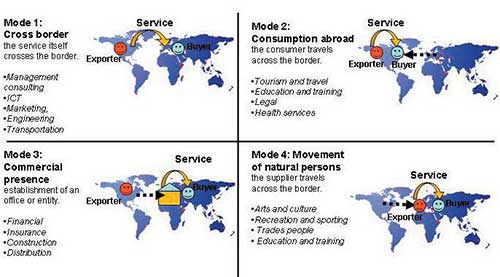
According to the World Trade Organization, over the past 20 years trade in services has become the most dynamic segment of world trade, growing more quickly than trade in goods.
Services represent in excess of 21 percent of world trade. Forecasters predict that this figure will reach 50 percent by the year 2025, as information and communication technologies continue to increase the tradability of services. The shift to knowledge-based economic activity also results in the assimilation of economic activities, which creates an increasingly integrated global economy. The outsourcing of inputs, including services, further fuels the integration process.
Trade in services between Canada and the U.S.
In both Canada and the U.S., the service sector is an important contributor to the economy. According to the U.S. Trade Representative’s Office, Trade in services with Canada (exports and imports) totaled an estimated $87.5 billion in 2015. Services exports to Canada totalled $57.3 billion, while services imports were $30.2 billion.
Trade in services was also a major job creator in the U.S. Exports of goods and services to Canada supported approximately 1.7 million jobs in the country in 2014.
Modes of Delivery: Four Ways Services Are Traded
Services include a wide range of activities. At one end of the spectrum are what might be termed personal services, such as training, live artistic performances and medical care. At the other end are impersonal services, such as telecommunications or the services embodied in manufactured products. In the case of telecommunications, for example, the service is delivered through automated equipment by a telephone company or a cable television operator.
The World Trade Organization (WTO) lists four modes of delivery or ways in which services are exported.

Mode 1: Cross-border
Cross-border trade takes place when the service itself crosses the border from one country to another without the movement of persons.
The service is transported either via electronic means (e-mail or fax) or by infrastructure, such as transportation services (air, rail, land or sea) or telecommunications (telephone or radio).
Examples:
- Management consulting: studies, reports, business plans, financial advice
- Information and communication technology: Internet service provision, cellular telephony
- Marketing: market research, advertising, articles
- Consulting engineering: feasibility studies, drawings
- Health: tele-health
- Education and training: e-learning, distance learning
- Transportation: courier services, other transportation services
Mode 2: Consumption abroad
Consumption abroad relates to services used by nationals of one country in another country where the service is supplied. This requires the consumer to travel across the border to another country to actually use the service. The supplier of the service, who is being paid by a “non-resident” customer, is technically exporting a service (even without leaving the country).
Examples:
- Tourism and travel-related services: tour operators, hospitality industry, business tourism, agri-tourism, eco-tourism, edu-tourism
- Education and training: study tours, conferences, foreign students, seminars
- Legal: client seeks legal advice in local market and so travels to the market
- Health: patient travels to foreign country for diagnosis and treatment
Mode 3: Commercial presence
Commercial presence refers to instances where a company from one country sets up subsidiaries or branches to provide services in another country.
Examples:
- Financial services: banks, investment companies, insurance brokers
- Construction engineering: sets up project offices to manage local infrastructure projects
- Information technology: local offices set up to service local clients
- Distribution: shipping, warehousing, logistics
Mode 4: Movement of natural persons
Movement of natural persons refers to individuals travelling from their own country to supply services in another country.
Examples:
- Arts and culture: film industry—actors, directors, production crew, performers
- Construction: architects, tradespeople
- Education and training: trainers, professional speakers
- Environmental: consultants, specialists
- Geomatics: mapping, oceanography
- Recreational and sporting: coaches, trainers, promoters
Companies become service exporters if they are paid for their services by a “non-resident” customer, regardless of where the service is provided.
The subtlety of services trade
For an export to take place, residents of one country pay residents of another for some kind of benefit. In the case of trade in goods, merchandise is physically shipped from one country to another, making tracking and measurement relatively straightforward. Trade in services is much more subtle.
Take, for example, the case of a multinational corporation with offices in two adjacent countries. If the subsidiary in one country ships components to the subsidiary in the other, the transaction is recorded both within the corporation and in the customs offices of both countries. But if a manager from one subsidiary travels to the subsidiary in the other country to participate in meetings and offer advice, the export of that manager’s services is not recorded anywhere. Yet, value—in the form of several days of the manager’s time—has been transferred from one country to the other.
Services may also be part of more complex international transactions. For example, a firm may be hired to build a subway system in another country. Part of the export will consist of subway cars, but an equally important component will be the design, planning, project management and training involved in constructing and operating the finished system. Some of these services will be delivered in person by individuals travelling to the site of the contract, falling under mode 4. Others, such as plans and schedules, can be transferred electronically, falling under mode 1.
Technology is outpacing services trade regulation
As information technology has become more sophisticated, databases, advanced software applications and the Internet have made it possible for many businesspeople to export their services without travelling abroad. This makes counting, controlling and regulating service trade more difficult.
For example, medical services are rigorously regulated in virtually every country of the world. A doctor qualified in one country cannot practice in another without first passing a series of examinations in the second country. Yet, medical technology already enables X-rays and other types of body scans to be transmitted over long distances for examination and diagnosis. In another example, a doctor in one country may be asked to offer an opinion on the case of a patient in another—in effect, practicing medicine in the patient’s country.
The service sector has become a significant economic force in the 21st century. As a result, countries are re-thinking national strategies, entrepreneurial service firms are reinventing themselves and economists are delighting in having new trends and numbers to assess, analyze and forecast.
It may be relatively easy to anticipate new trends, but being in a position to capitalize on them is a different matter. Services are invisibles. They cannot be demonstrated, shipped and returned as products can.
Successful service firms have recognized that in selling these kinds of services, the key to success is in the building of relationships, the adaptation of services to meet customer needs and the continuous innovation of unique high-value solutions.







disqus comments